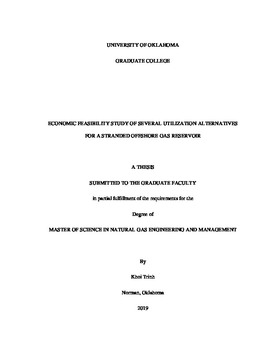| dc.description.abstract | Floating Liquefied Natural Gas (FLNG) has been on the rise in recent years to meet growing energy demand, worldwide. As energy consumption and exploitation of onshore unconventional gas reservoirs continue to grow while gas price remains almost steady, FLNG can potentially become the winning card for operators in conventional offshore gas fields through integration of upstream and midstream processes on the spot.
This thesis compares project economics of a FLNG utilization to those of onshore LNG plant, and Gas-to-Wire (GTW) processes. We primarily conducted sensitivity analysis and tornado charts to evaluate importance of various uncertain parameters associated with FLNG construction and operation. Costs for the hypothetical FLNG vessel is taken from Shell’s Prelude FLNG; while pipeline, LNG plant, and gas-to-wire costs were obtained from typical industry standards. A typical hyperbolic decline curve model is applied to model depletion flow regime of production life after 5 to 10 years constant rate plateau time.
Several factors are included in the sensitivity analysis: LNG price, interest rate, initial production rate, and condensate-to-gas ratio (CGR), plateau time, distance from onshore, electricity price, natural gas price and percentage share of overnight capital cost of building a power plant to convert gas to electricity. The factors are used to gauge their effects on the net present value (NPV) of each scenario and are ranked based on their sensitivity on a tornado chart. The analysis suggest that initial production rate has the strongest effect on NPV, followed by discount rate, LNG price, CGR, and the distance from onshore when the reservoir is dry gas. Our analysis showed that, the longer the distance from onshore, the more attractive the FLNG alternative becomes. However, when gas price is low, and a subsidy from the Nigerian government can be obtained, GTW becomes attractive.
This economic feasibility study will be helpful for future considerations to use FLNG to make previously considered stranded offshore gas reservoir economically viable. This will certainly play a key role in the future of natural gas industry and energy market, especially in West Africa. | en_US |

